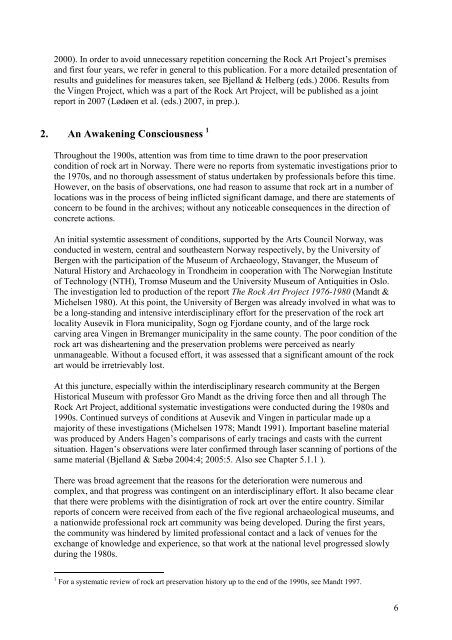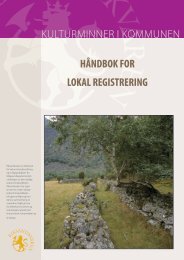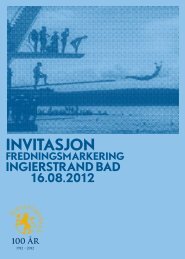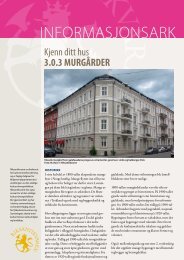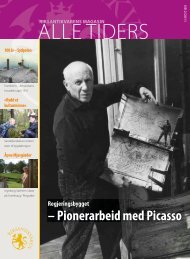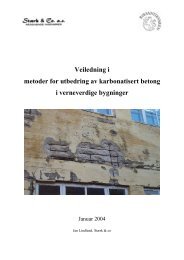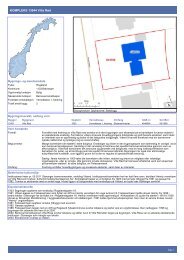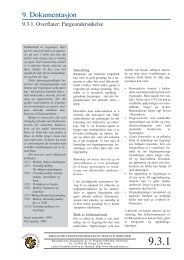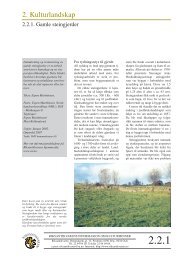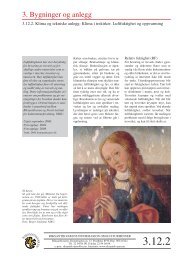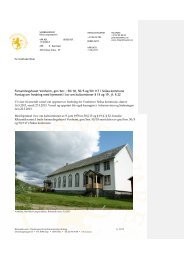Protection of Rock Art - Riksantikvaren
Protection of Rock Art - Riksantikvaren
Protection of Rock Art - Riksantikvaren
Create successful ePaper yourself
Turn your PDF publications into a flip-book with our unique Google optimized e-Paper software.
2000). In order to avoid unnecessary repetition concerning the <strong>Rock</strong> <strong>Art</strong> Project’s premises<br />
and first four years, we refer in general to this publication. For a more detailed presentation <strong>of</strong><br />
results and guidelines for measures taken, see Bjelland & Helberg (eds.) 2006. Results from<br />
the Vingen Project, which was a part <strong>of</strong> the <strong>Rock</strong> <strong>Art</strong> Project, will be published as a joint<br />
report in 2007 (Lødøen et al. (eds.) 2007, in prep.).<br />
2. An Awakening Consciousness 1<br />
Throughout the 1900s, attention was from time to time drawn to the poor preservation<br />
condition <strong>of</strong> rock art in Norway. There were no reports from systematic investigations prior to<br />
the 1970s, and no thorough assessment <strong>of</strong> status undertaken by pr<strong>of</strong>essionals before this time.<br />
However, on the basis <strong>of</strong> observations, one had reason to assume that rock art in a number <strong>of</strong><br />
locations was in the process <strong>of</strong> being inflicted significant damage, and there are statements <strong>of</strong><br />
concern to be found in the archives; without any noticeable consequences in the direction <strong>of</strong><br />
concrete actions.<br />
An initial systemtic assessment <strong>of</strong> conditions, supported by the <strong>Art</strong>s Council Norway, was<br />
conducted in western, central and southeastern Norway respectively, by the University <strong>of</strong><br />
Bergen with the participation <strong>of</strong> the Museum <strong>of</strong> Archaeology, Stavanger, the Museum <strong>of</strong><br />
Natural History and Archaeology in Trondheim in cooperation with The Norwegian Institute<br />
<strong>of</strong> Technology (NTH), Tromsø Museum and the University Museum <strong>of</strong> Antiquities in Oslo.<br />
The investigation led to production <strong>of</strong> the report The <strong>Rock</strong> <strong>Art</strong> Project 1976-1980 (Mandt &<br />
Michelsen 1980). At this point, the University <strong>of</strong> Bergen was already involved in what was to<br />
be a long-standing and intensive interdisciplinary effort for the preservation <strong>of</strong> the rock art<br />
locality Ausevik in Flora municipality, Sogn og Fjordane county, and <strong>of</strong> the large rock<br />
carving area Vingen in Bremanger municipality in the same county. The poor condition <strong>of</strong> the<br />
rock art was disheartening and the preservation problems were perceived as nearly<br />
unmanageable. Without a focused effort, it was assessed that a significant amount <strong>of</strong> the rock<br />
art would be irretrievably lost.<br />
At this juncture, especially within the interdisciplinary research community at the Bergen<br />
Historical Museum with pr<strong>of</strong>essor Gro Mandt as the driving force then and all through The<br />
<strong>Rock</strong> <strong>Art</strong> Project, additional systematic investigations were conducted during the 1980s and<br />
1990s. Continued surveys <strong>of</strong> conditions at Ausevik and Vingen in particular made up a<br />
majority <strong>of</strong> these investigations (Michelsen 1978; Mandt 1991). Important baseline material<br />
was produced by Anders Hagen’s comparisons <strong>of</strong> early tracings and casts with the current<br />
situation. Hagen’s observations were later confirmed through laser scanning <strong>of</strong> portions <strong>of</strong> the<br />
same material (Bjelland & Sæbø 2004:4; 2005:5. Also see Chapter 5.1.1 ).<br />
There was broad agreement that the reasons for the deterioration were numerous and<br />
complex, and that progress was contingent on an interdisciplinary effort. It also became clear<br />
that there were problems with the disintigration <strong>of</strong> rock art over the entire country. Similar<br />
reports <strong>of</strong> concern were received from each <strong>of</strong> the five regional archaeological museums, and<br />
a nationwide pr<strong>of</strong>essional rock art community was being developed. During the first years,<br />
the community was hindered by limited pr<strong>of</strong>essional contact and a lack <strong>of</strong> venues for the<br />
exchange <strong>of</strong> knowledge and experience, so that work at the national level progressed slowly<br />
during the 1980s.<br />
1 For a systematic review <strong>of</strong> rock art preservation history up to the end <strong>of</strong> the 1990s, see Mandt 1997.<br />
6


